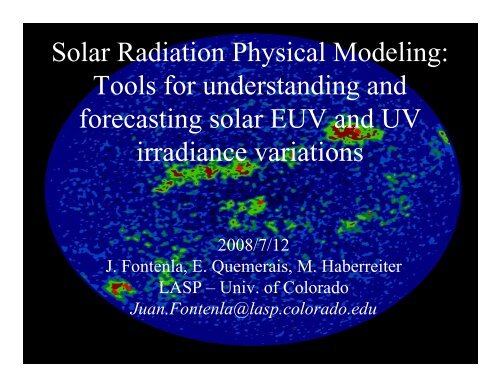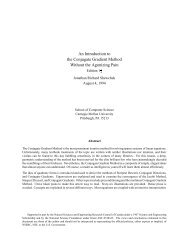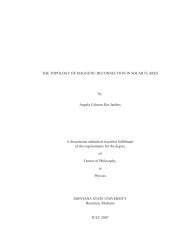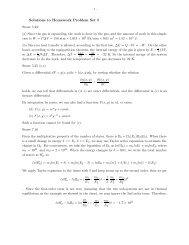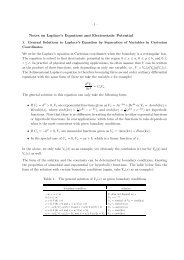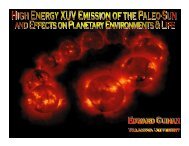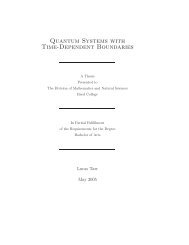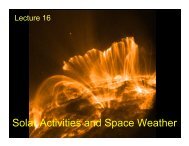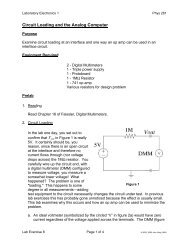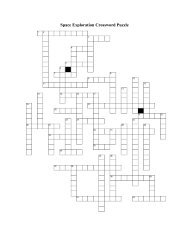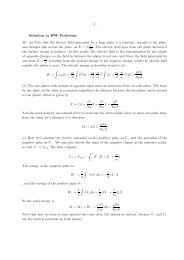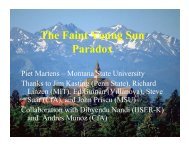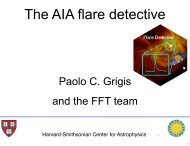You also want an ePaper? Increase the reach of your titles
YUMPU automatically turns print PDFs into web optimized ePapers that Google loves.
<strong>Solar</strong> Radi<strong>at</strong>ion Physical Modeling:Tools for understanding andforecasting solar EUV and UVirradiance vari<strong>at</strong>ions2008/7/12J. <strong>Fontenla</strong>, E. Quemerais, M. HaberreiterLASP – Univ. of Colorado<strong>Juan</strong>.<strong>Fontenla</strong>@lasp.colorado.edu
SRPM Project Goals•Diagnosis of physical conditions through thesolar <strong>at</strong>mosphere; energy balance of radi<strong>at</strong>ivelosses and mechanical he<strong>at</strong>ing.•Evalu<strong>at</strong>ing proposed physical processes todetermine the solar <strong>at</strong>mosphere structure andspectrum <strong>at</strong> all sp<strong>at</strong>ial and temporal scales.•Synthesizing solar irradiance spectrum andits vari<strong>at</strong>ions to improve the above and producecomplete and quantit<strong>at</strong>ive physical models.•Forecasting spectral irradiance <strong>at</strong> any time andposition in the Heliosphere. Weekly and monthlyforecast is now becoming possible.
Layers of the solar <strong>at</strong>mosphere• Photosphere (using average 1D models and external 3D simul<strong>at</strong>ions)– Slow motions (few km/s) domin<strong>at</strong>ed by convection overshoot– Weak ioniz<strong>at</strong>ion– All particles are unmagnetized– Plasma beta > 1– At or near LTE• Chromosphere (using average 1D models and 3D MHD simul<strong>at</strong>ions)– Motions and inhomogeneities change from weak to strong– Weak ioniz<strong>at</strong>ion (n p
SRPM Flow Scheme0.8Carbon Ioniz<strong>at</strong>ion and Mass FLow......... St<strong>at</strong>ic case (w/dif)_____ Upflow case (w/dif)Ioniz<strong>at</strong>ionFraction0.60.40.20.010 4 2 3 4 5 6 7 8 9n lev ,n ion ,…(x,y,z,t)10 5 2 3 4 5 6 7 8 9Temper<strong>at</strong>ure (K)10 6Intermedi<strong>at</strong>eParametersEmittedSpectrumI(λ,µ,φ,t)Physical Models& ProcessesObservedSpectrumT,ne,nh,U,...(x,y,z,t)I(λ,µ,φ,t)
Photosphere (radi<strong>at</strong>ion/convection)Stein & Nordlund 2000 convection simul<strong>at</strong>ions snapshotsSRPM absolute radiance, wavelength and CLV dependenceC I 5381Mg I 4572CN band500 nm 800 nm 1200 nm 1600 nmSlit spectrum8000SRP M 306Stein & NordlundSRP M 306 * 0.95400Temper<strong>at</strong>ure (K)6000Height (km)20040000SRPM 306Stein & NordlundSRPM 306 + 30 km1 . 10 3 1 . 10 4 1 . 10 5 1 . 10 61 .10 3 1 .10 4 1 .10 5 1 .10 6Pressure (dyne cm^-2)Pressure (dyne cm^-2)Comparison of sp<strong>at</strong>ial averages with semi-empirical modelspoints to improvements in average models and in simul<strong>at</strong>ions
<strong>Solar</strong> Chromosphere(radi<strong>at</strong>ion/plasma he<strong>at</strong>ing)Discrete set of fe<strong>at</strong>uresassigned to varioushe<strong>at</strong>ing levels.BDFUV (1540 A) continuumMDI magnetogramLog-normal distributionof he<strong>at</strong>ed areas in quietSun, probably due tosimilar distribution ofmagnetic fe<strong>at</strong>ures.LyαCa II K 3UV continuumRed cont.
Active Sun chromospheric fe<strong>at</strong>uresSunspot umbra and penumbr<strong>at</strong>aken from continuum images,but plage and network pixelsfrom Ca II K d<strong>at</strong>a.Super-he<strong>at</strong>ed (plage) fe<strong>at</strong>uresin active regions are discretizedby two components.H P1Number of Pixels (rel<strong>at</strong>ive to total)0.10.011 .10 31 .10 40.9 0.95 1 1.05 1.1 1.15Intensity (rel<strong>at</strong>ive to median)
A set of models discretizes thedistribution of he<strong>at</strong>ed areas(other models for sunspot umbra &penumbra are not shown here)Upper chromosphere Lower chromosphere8000Temper<strong>at</strong>ure (K)60004000B 1001D 1002F 1003H 1004P 10050.1 1 10 100 1 .10 3 1 .10 4 1 .10 5Pressure (dyn cm^-2)Semi-empirical, in-pixel.NLTE radi<strong>at</strong>ive transfermodels built to account forthe radiance observ<strong>at</strong>ions.
Transition region(radi<strong>at</strong>ion/conduction+diffusion+flows)Quiet Sunhva+ hvas, hda+hdas,h4Temper<strong>at</strong>ure (K)1 .10 6 Vernazza & Reeves d<strong>at</strong>a1 .10 51 .10 4Vernazza & Reeves d<strong>at</strong>aDeere et alB 10011 .10 31.9 .10 8 1.95.10 8 2 .10 8 2.05.10 8 2.1 .10 8 2.15.10 8 2.2 .10 8Temper<strong>at</strong>ure (K)1 .10 6 AR Vernazza & Reeves d<strong>at</strong>a1 .10 51 . 10 4AR Vernazza & Reeves d<strong>at</strong>aAR Deere et alH 10041 .10 31.82.10 8 1.83.10 8 1.84.10 8 1.85.10 8 1.86.10 8Height (cm)Height (cm)The low transition-region (T < 200,000 K) is strongly affectedby optically thick NLTE radi<strong>at</strong>ive transfer and particle diffusioneffects up to ~60,000 K. Above th<strong>at</strong> the energy balance model isclose to the DEM standard curves for comparable abundances(note th<strong>at</strong> SRPM uses abundances similar to Dere values).
Upper transition-regionTemper<strong>at</strong>ure (K)1 . 10 65 . 10 51.5 . 10 6 Vernazza & Reeves d<strong>at</strong>a2.5 .10 6Vernazza & Reeves d<strong>at</strong>aDeere et alB 1011Temper<strong>at</strong>ure (K)2 .10 61.5 . 10 61 .10 65 .10 53 .10 6 AR Vernazza & Reeves d<strong>at</strong>aAR Vernazza & Reeves d<strong>at</strong>aAR Deere et alP 10152 .10 8 4 .10 8 6 .10 8 8 .10 8 1 .10 9 1.2 .10 9 1.4 .10 9Height (cm)5 .10 8 1 .10 9 1.5 .10 9Height (cm)Upper transition-region (T > 200,000 K) energy balance modelsare also close to the DEM ones with similar abundances. In theenergy balance models conduction domin<strong>at</strong>es <strong>at</strong> the bottom butlocal energy dissip<strong>at</strong>ion becomes important <strong>at</strong> the top.
Corona and upper transition region(radi<strong>at</strong>ion+conduction+solar wind)QuietActiveTemper<strong>at</strong>ure (K)6 .10 6 Vernazza & Reeves d<strong>at</strong>aDeere et alSRPM 10014 .10 62 . 10 6Temper<strong>at</strong>ure (K)6 . 10 6 AR Vernazza & Reeves d<strong>at</strong>aAR Deere et alSRPM 10154 .10 62 .10 65 .10 9 1 .10 10 1.5 .10 10 2 .10 10 2.5 .10 105 .10 9 1 .10 10 1.5 .10 10 2 .10 10 2.5 .10 10Height (cm)Height (cm)The temper<strong>at</strong>ure reaches a maximum value (local energy dissip<strong>at</strong>ionis essential) and decreases again in the heliosphere. DEM cannothandle this behavior. <strong>Solar</strong> wind and coronal holes are fe<strong>at</strong>ures toconsider. In active regions, groups of hot loops are the key fe<strong>at</strong>ure.
Tools for forecasting solar irradianceAssuming previous curve is bad Images of the near-side produce daily masks of fe<strong>at</strong>uresLy alpha irradiance0.00750.0070.0065Current rot<strong>at</strong>ionShifted previous rot<strong>at</strong>ion0.00610 20 30 40 50 60 70 80 90Days since 2005/8/1Using <strong>at</strong>mospheric models thespectrum is computed for any daySynoptic masks are refined by applying trendsNOAA 10808and far-side imaging:(far side)AR helioseismic image1 .10 7 CLog(T)6 CEFH540.01 0.1 1 10 100 1 .10 3 1 .10 4 1 .10 5Pressure (dyne cm^-2)Intensity (erg cm^-2 s^-1 sr^-1)1 .10 61 .10 51 .10 41 . 10 3EFH1215.5 1216WavelengthEARTHCourtesy of D. BraunWithout refinement thesynoptic mask fe<strong>at</strong>uresobsolescence makes it badAR backsc<strong>at</strong>tered imageNOAA 10808(near side)
EUV radiance spectra of solar fe<strong>at</strong>uresFe<strong>at</strong>ures radiance spectraCombined QS radiance spectrumIntensity (mW m^-2 A^-1 sr^-1)1 .10 5 B 1001D 1002F 1003SUMER QS1 .10 41 .10 3100101Intensity (mW m^-2 A^-1 sr^-1)1 .10 5 SRPM QSSUMER QS1 .10 41 .10 31001010.1600 700 800 900 1000 1100 1200 1300 1400 1500 16000.1600 700 800 900 1000 1100 1200 1300 1400 1500 1600Wavelength (A)Wavelength (A)The models computed radiance m<strong>at</strong>ches the SOHO/SUMER spectraas the models were build for th<strong>at</strong>. They provide other spectral rangesand extremely high resolution too. The QS combin<strong>at</strong>ion of models(0.75 B+0.22 D+0.03 F) nearly m<strong>at</strong>ches the average QS in Curdt et al.<strong>at</strong>las. (Preliminary spectra, work in progress..)
High resolution examplesChromosphericradiance exampleIntensity (mW m^-2 A^-1 sr^-1)600400200SRPM QSSUMER QS01455 1460 1465 1470 1475Wavelength (A)Irradiance (W m^-2 nm^-1)1 .10 3 100B 1001Rocket flight0.10.011 .10 31 . 10 41 .10 51 .10 61 .10 7101Low transition-regionirradiance example1 .10 850 52 54 56 58 60Wavelength (nm)In general there is good agreement on lines but individual linescan be off because of uncertainties in <strong>at</strong>omic d<strong>at</strong>a (mainlycollisional excit<strong>at</strong>ion r<strong>at</strong>es). Also, so far we have not completedthe runs for the spectra of upper transition-region+coronal partsof the models which contribute many lines.
Preliminary Active RegionChromosphericLower transition-regionIntensity (erg s^-1 cm^-2 A^-1 sr^-1)1 .10 6 SRPM QSH 1004SUMER QSSUMER Plage1 .10 51 .10 41 .10 310010Intensity (erg s^-1 cm^-2 A^-1 sr^-1)1 .10 6 SRPM QS1 .10 5H 1004SUMER QSSUMER Plage1 .10 41 .10 31001011250 1300 1350 1400 1450 15001700 750 800 850 900 950 1000 1050 1100 1150 1200Wavelength (A)Wavelength (A)The UV chromospheric continuum m<strong>at</strong>ches fine inmodel P. However, improvement is needed in thelower transition-region of the active region models.


